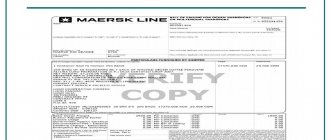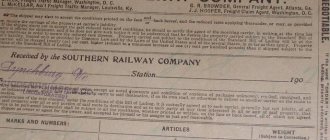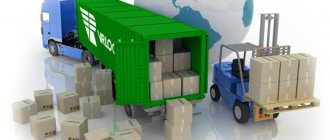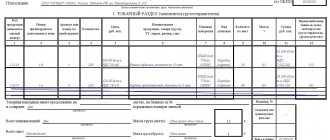All international transportation of goods by car requires the execution of accompanying documentation. You will need to collect a certain package of official papers. The documents must include a CMR bill of lading (CMR). It is recommended to understand in more detail what it is and for what purposes it is used.
What data does the international CMR consignment note contain?
CMR is a document reflecting basic information regarding the movement of cargo across the border. From the international CMR consignment note you can find out the following information:
- quantity of goods transported, its nature;
- information about the carrier company;
- place of origin of the goods and information about the sender;
- who is the recipient of the cargo;
- transportation route;
- documentation on the basis of which transportation is carried out;
- delivery terms.
The same invoice indicates which goods, when and in what form they arrived at customs. Each of the parties to the agreement must have duplicates of this document with them.
It is worth noting that the CMR invoice contains all the same information as the bill of lading. However, unlike the latter, the DEM does not perform a commodity distribution function.
Construction and installation work organization
Various organizations take part in the construction process.
To ensure uninterrupted operation and phased commissioning of finished parts of the facility, a system of continuous planning and execution of work is required.
There are three main methods of organizing the technological process that determine what is included in construction and installation work in construction:
- Consistent. In this method, certain activities are performed one after another, i.e., the next one begins no earlier than the end of the previous one.
- Parallel. It is based on the greatest possible combination of different processes in a single period of time. This allows several buildings to be erected simultaneously, but requires a significant amount of labor and technology.
- In-line. It consists of dividing complex processes that are combined over time into simpler operations that are performed sequentially. All actions are divided into threads performed in a clearly defined period of time. In each facility included in the flow, construction and installation work is carried out by integrated teams that move from room to room, which allows the staff to be evenly loaded and ensure rhythmic work at the sites.
How to fill out a CMR and what should you follow when doing so?
A CMR consignment note is issued provided that the country where the sender or recipient of the cargo resides has ratified the part of the agreement of the CMR Convention (on the contract for the international carriage of goods by road) dated 05.19.56, which deals with international road freight transportation.
The rules of this convention regulate the rules of road transportation and the procedure for formalizing legal relations between the three parties to the contract - sender, carrier, recipient. The regulations also apply to the transport of goods from municipal institutions. The CMR invoice sample is unified for all countries that have ratified the Convention. However, you should know that this document is not recognized by all states; such a document is required to be drawn up in European countries.
In Russia, the form and rules for filling out are regulated by letter of the Federal Customs Service of the Russian Federation dated May 2, 2012 No. 04-30/22006. In the absence of an international consignment note, the cargo may be seized, and the sender and carrier may be subject to penalties, the amount of which is determined by the legislation of the state in which the incident occurred.
What types of invoices are there?
Depending on the type of vehicles carrying out cargo transportation and the governing normative documents, several types of consignment notes are distinguished:
- AWB consignment note – for air transportation;
- RWB consignment note – for transporting goods by rail;
- bill of lading – for sea cargo transportation;
- CMR consignment note – for transportation by road.
Note! Multimodal transportation is a complex of these types of transportation (plus cargo transshipment at terminals), therefore, to carry it out, you need to issue all the necessary types of invoices.
What information should be indicated in an international document - main sheets
The first four pages of the CMR invoice are the main ones and have their own names:
- supplier copy;
- sample for the consignee;
- sample for the carrier;
- copy for calculations.
Page No. 1 serves as confirmation of shipment and payment for the goods; after completion, it remains in the hands of the supplier.
The second page confirms the delivery of the goods; it is handed over first to the carrier company, then to the driver. After the cargo is delivered, the driver gives the copy to the recipient. This page is certified by the signatures of the carrier and supplier, as well as special seals.
Page No. 3 is for the carrier; it is attached to the waybill when transporting the goods. When calculating the driver's salary, the information provided here will serve as the basis. This page is needed for registration data; the sender of the cargo puts his signature and stamp on it.
The fourth page, which indicates the cost of the goods, is filled out by the carrier company. It is transferred to the person paying for transportation - either the sender or the recipient of the goods. Certified with the stamps of the carrier and sender.
The CMR consignment note contains two main categories of information: basic information about the transportation of goods, placed in special columns, and marks and seals about the progress of transportation.
Having problems with international transportation?
Does the correct execution of CMR and other documents take a lot of time and nerves? Refer these and other foreign trade problems to EIG professionals, because problem solving is our job!
Or contact us by phone,
Or via email
Kinds
Construction involves a combination of a huge number of actions in different directions using a wide variety of materials and specialized equipment. Construction and installation work is the use of various methods of organizing production processes in construction.
The project can be implemented in several different ways:
- conclusion of contracts that provide for the implementation of all stages by specialized companies;
- all work is carried out by the company’s own departments;
- in a mixed way, in which one part of the work is carried out by contractors, and the other by oneself.
Based on the concept and expected result, the following main types of construction and installation work are distinguished: general construction, transport, loading and unloading, special.
Installation is carried out using prefabricated parts, power wiring and other cables, reinforced concrete and metal structures.
General construction activities are based on the processing of materials and the construction of structural elements. They are divided into established types. Construction and installation work by type of construction can be classified as follows:
- Excavation. They include excavation of holes, trenches for installation of strip foundations and individual supports, underground utility networks of various lengths.
- Pile. Driving or driving piles, preparing the foundation.
- Stone. Construction of piers, walls, columns and other structures from blocks, masonry from crushed stone, brick, natural and artificial stones.
- Reinforced concrete and concrete. Preparation of the mixture, its transportation and pouring into formwork, maintenance, processing of compositions and prefabricated elements.
- Assembly. Delivery of structural parts to the destination, their alignment, installation and fastening.
- Joinery and carpentry work. They involve the supply and installation of finished wooden parts (doors, windows).
- Roofing. They consist of covering roofs with asbestos-cement or steel sheets.
- Plastering. For large volumes, mechanical feeding is used and for small volumes, manual application of the solution is used.
- Facing. They involve covering vertical and horizontal surfaces with large and small slabs, as well as sheet materials.
- Painting. They consist of manual or mechanical painting of structures, as well as wallpapering walls.
Some of these technological processes are combined into the concept of “zero cycle,” which is the initial phase of construction and includes preparation of the site and access roads to it, excavation work, and laying the foundation. It is completed when the underground part of the building is erected and utility networks are laid.
Filling out the remaining sheets of the CMR invoice
The carrier company is responsible for the 10th column of the invoice. She fills out points 16 to 19, 23 and 25 to 29. Three points - from 15 to 18 - information about the carrier and the reservations that the carrier has in relation to the cargo. Reservations may relate to the packaging of the goods, the quality of loading by the supplier, the condition of the cargo, here you can indicate who is performing the loading work, etc. If there are none, the field is left blank. Information about the driver and characteristics of the vehicle are placed in columns 23, 25,26.
Points 19, 27-29 are information about the cost of transportation - tariff, list of additional services and their price. When transporting on the basis of an agreement, these columns do not need to be filled in. But the driver can start work only after he has a delivery note signed by the sender.
The remaining pages of the CMR invoice are completed by customs services and other responsible authorities. The exact number of pages depends on the type of transportation; they are filled out by the relevant services.
Important! The presence of the carrier's reservations can protect him from claims when the cargo is delivered from the recipient, since the former is responsible for damage or loss of the cargo. Therefore, depending on the completion of column 18, the issue of the transport company’s responsibility for the safety of the cargo will be decided.
General overview
Construction as an industry includes a wide range of work. This is not only the construction of new buildings and structures, but also activities to carry out their repair (current and major), restoration, and reconstruction.
Construction and installation work (in construction) means construction and installation work. Their main characteristics:
- the implementation process goes through several successive stages: drawing up a marketing plan, justifying the project parameters, identifying a contractor, etc.;
- geodetic works;
- development of project documentation;
- stage of material support (purchase of necessary products and raw materials, their transportation to sites);
- construction and installation (preparatory, basic and finishing) work;
- commissioning (control measures and necessary tests).
There are several interpretations of the term “construction and installation work”. Different wording depends on the vocabulary used and legal regulations. At the same time, they all agree that construction and installation work in construction is the application of a specific list of sequential operations that are aimed at the construction of buildings and structures, installation of the necessary equipment (ventilation, heating systems, gas and water supply, wastewater disposal, etc.). d.).
To shorten technical documentation, it is customary to write construction and installation works.
Additional documentation – is it necessary to provide it?
The fifth column indicates the types of documents that are attached to the international consignment note. In this case, the shipper may note the following documentation:
- When transporting animals or raw materials of animal origin, feed, drugs for treating animals - a veterinary certificate.
- If products subject to quarantine are transported, a quarantine certificate is required.
- Phytosanitary certificate – if plants are transported.
- Quality certificate - for transportation of industrial and food products.
- Shipping specification.
- Necessary permits from authorities, if necessary.
- An act confirming the loading of transport.
- Invoice.
All data specified in the provided additional documentation must necessarily coincide with the information specified in the CMR consignment note. Discrepancies will cause problems with customs clearance of cargo.
What must the shipper fill out?
The sender of the cargo must fill out 17 points of the CMR consignment note - from 1 to 15, 21 and 22. These columns of the CMR consignment note contain the following information:
- information about the sender;
- about the recipient of the cargo;
- final point of cargo delivery;
- loading data – date and time;
- documentation on the product, characteristics of the cargo, its features;
- terms of payment;
- details of customs control where the cargo is delivered;
- place and time of drawing up the CMR invoice.
Box number 23 can also be filled in by the cargo supplier. In it he must indicate the date of dispatch of the goods and the number of the waybill. Transportation takes place on the basis of this document.
Registration procedure
Documents must be completed by the shipper. If the form is drawn up incorrectly, all consequences will fall on his shoulders; the carrier is not responsible for these errors.
To quickly fill out the document, it is important to follow a certain procedure for filling out the TTN SRM - this is the following sequence of actions:
- The sender must pay attention to subparagraphs 1-15, 21-22.
- The carrier fills out boxes 16-19, 23, 25-29.
- The consignee signs and stamps in box 24.
Let's look at these subsections in more detail. The procedure for filling them out is indicated in the Letter of the Russian Federation of 2012 “On sending information.”
A guide to the CMR form and how to fill it out correctly is presented below.
CMR insurance – what is it?
For those who are cargo carriers, CMR insurance plays a big role. If the cargo is damaged or lost, the transporter is obliged to pay damages to the recipient of the goods. Thus, insurance is designed to protect the interests of the carrier and other parties to the contract.
In what cases can insurance play an important role?
- If the loss/damage did not occur through the fault of the carrier company (theft, vehicle theft, accident, adverse weather conditions).
- In case problems with the cargo arose due to the carrier (violation of traffic rules, intentional damage to property, fraud, etc.)
- Violation of delivery procedures, customs clearance, delay of the agreed period and before.
If the cargo is damaged during transportation or is not delivered on time, the carrier must bear all costs. Thus, many companies prefer to take out carrier liability insurance.
If you take out a 100% type of insurance, the carrier will be able to receive compensation for damage caused by his fault.
What does "franchise" mean?
You need to know that when taking out insurance, the contract may indicate a so-called deductible. What is this concept? A deductible is the amount of loss that is not covered by the insurance company. For example, a deductible of $1,000 specified in an insurance contract means that if losses are less than this amount, compensation will not be paid to the carrier.
In addition, with CMR insurance, such concepts as conditional and unconditional deductible apply. The first provides for the payment of the entire amount of compensation if the damage caused exceeds $1,000. But in the case of an unconditional franchise, a different rule applies: the carrier will receive only an amount exceeding the franchise amount. For example, if the damage is 1600 USD. there is a chance to receive compensation of only $600.
If an insured event occurs during transportation, according to the CMR Convention, the insurance company will compensate the damage only to the carrier.
Quality control
A construction contract imposes great responsibility on the contractor, since poor quality of work, use of inferior materials and failure to comply with approved standards can lead to the destruction of sites, large financial losses or loss of life.
Therefore, the level of construction and installation work at each stage is of particular importance. The quality of materials affects the cost and performance characteristics of the structure.
When constructing facilities using low-grade raw materials, the cost of all processes increases due to the need to constantly correct identified deficiencies, increase operating costs, and reduce the level of comfort of residents.
The essence of control is to verify the compliance of the actual indicators of the object with the approved requirements set out in technical specifications, standards, projects, contracts, passports.
The main task is to prevent marriage and defects and maintain proper product quality. There are two forms of control: internal and external.
The first is carried out directly by employees of enterprises (design, industrial) that produce the necessary products. Factories and factories that produce building materials issue documents and passports that confirm compliance with state standards. The presence of such a document upon delivery of products is mandatory.
External quality control includes audits carried out by organizations that have oversight rights and are independent.
Advantages and disadvantages
There are many conflicting opinions about whether or not it is profitable to take out CMR insurance, since this solution has both strengths and weaknesses.
If the carrier has a CMR insurance policy in hand, the transport company receives the following benefits:
- Guarantee of financial compensation for damage. If the cargo is stolen or lost due to the fault of the carrier itself or the authorized capital of the transport company is several times lower than the potential damage, such insurance will be a reliable guarantee that the organization will not go bankrupt while paying losses to the sender.
- Prestige and high status in the eyes of clients. A transport company that has a CMR insurance policy is considered reliable and inspires confidence among potential customers. This is a guarantee of its reality, integrity, and capacity.
However, there is a flip side to the coin that you should also think about. The following disadvantages can be noted in the CMR insurance system:
- The company's refusal to pay insurance under the policy. This often happens if the cargo is damaged by a third party, or the goods are simply lost, as well as when vehicles get into an accident.
- Waste of time. Compensation for losses under a policy is a very lengthy process; you will have to prepare a lot of documents and spend a lot of effort.
- Limitation of liability established and limited by law.
The practice of international cargo transportation shows that CMR insurance is used in most cases. Having a policy for a carrier opens up the prospect of having serious profitable clients: some customers, when choosing a transport company, first of all pay attention to this point.
The East Import Group company offers its services to help fill out CMR and other customs clearance. With us you can be sure that your goods will arrive on time
Please help make this article better.
To do this, answer just 3 questions. Contact us
+7,,
Get a quoteAsk a question
Disadvantages of taking out an insurance policy
In addition to the advantages, having insurance comes with certain disadvantages. These include the following disadvantages of construction and installation insurance – these are the facts listed below:
- If damage to the cargo was caused by an unauthorized person, the insurance company may refuse to pay compensation.
- To obtain compensation for damage, you need to spend a lot of time preparing the required package of documents.
- Sometimes the carrier's liability may be limited by the specifics of legislation and certain limits.









